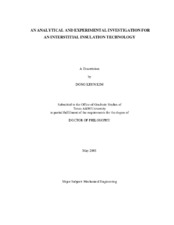| dc.description.abstract | An insulation technique has been developed which contains a single or combination
of materials to help minimize heat loss in actual industrial applications. For the
petroleum industry, insulation for deep sea piping is one of the greatest challenges
which would prevent the industry from meeting the high demand for oil through
exploration into deeper ocean environments. At current seafloor depths
(5,000~10,000ft), pipeline insulation is essential in preventing pipeline blockage
resulting from the solidification of paraffin waxes and / or hydrate formation which
exist in crude oil. To maintain crude oil temperatures above the paraffin solidification
point (68°C or 155°F), new and better insulation techniques are essential to minimize
pipeline heat loss and maintain crude oil temperatures. Therefore, the objective of this
investigation was to determine whether or not the thermal resistance of a new
insulation concept, which involves IIT (Interstitial Insulation Technology) with screen
wire, was greater than existing readily available commercial products through analytical modeling and experimentation. The model takes into account both
conforming and nonconforming interfaces at the wire screen contacts within the
interstitial space between coaxial pipes.
In addition, confirmation was needed to determine whether or not laboratory testing
of simulated coupons translate to thermal performance for a prototype pipe segment
that fabricated with two layers of low conductivity wire-screen (stainless steel) as the
interstitial insulation material. Both the inner and outer surface temperatures of the
coaxial pipes were measured in order to evaluate the effective thermal conductivity and
thermal diffusivity of the insulation concept. The predicted results from the model
compared very favorably with the experimental results, confirming both the trends and
magnitudes of the experimental data. In other words, whether the reduction in heat
transfer observed for small laboratory samples was realistic for application to a pipeline
configuration. This effort involved both analytical modeling for all thermal resistances
and experimental test runs for validation of the analytical model.
Finally, it was a goal of this investigation to develop a simplified model for a
multilayer composite structure which will include radiation heat transfer exchange
among the layers that constitute the insulation. With the developed model, feasibility
and performance characteristics of the insulation concept were predicted. The thermal
predictions have demonstrated the thermal competitiveness of the interstitial insulation
technology. | en |


